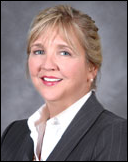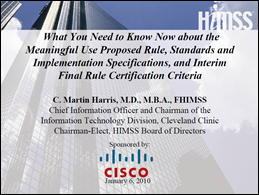EMR Vendor Executives on Meaningful Use and Certification Requirements – Part One of a Series
We asked several vendors a series of six questions related the federal government’s recent announcement on the latest proposed meaningful use definitions and EHR certification criteria.
Were any of the proposed meaningful use criteria a surprise and what effort will be required for your product to meet them?
Allscripts – Glen Tullman, CEO
Since we have been involved in and following the process very closely, there were no surprises. That said, Allscripts has been very supportive of raising the bar for Electronic Health Record certification for vendors and challenging physicians to aggressively use the technology so we could truly begin to improve healthcare and so taxpayers would get the return on investment they expect and deserve from the billions they’re investing in healthcare IT. We like the 80% standard on CPOE, the clinical support rules, and the push toward delivering electronic information to patients — if we’re building an electronic healthcare highway, patients need an on-ramp — but we hope that this is simply the minimum requirements and that the Government pushes much more aggressively. We know that vendors and physicians can do more and if we are to address the challenges of quality and cost in our healthcare system, we simply can’t wait any longer.
With that said, Allscripts has a development budget that exceeds the annual revenue of many of our competitors and we will meet and exceed the criteria, once they are finalized. In fact, tomorrow Allscripts will make an important announcement relative to Meaningful Use and our approach as an organization. Along with the financing programs we already have in place, which bridges the gap until physicians receive their stimulus funding, we believe this new announcement will make Allscripts the safe and easy choice.
eClinical Works – Girish Kumar Navani, CEO and co-founder
We understand that the bar has been set low in order to have a high adoption rate. Living in the public domain where our customers have already demonstrated meaningful use has provided us with valuable insight. An example is NYC’s Primary Care Information Project (PCIP), which has 1800 physicians using the system and our payment is tied to the successful deployment of the EMR along with clinical decision support and measurement reporting for aspects of care including diabetes, hypertension and smoking cessation. Some of these data collecting and reporting requirements are more stringent than those set forth under meaningful use
Eclipsys – Philip M. Pead, President and CEO
The meaningful use criteria published in the CMS Interim Final Rule (IFR) are substantially in line with previous guidance with one exception. That exception is the number and scope of reportable Quality Measures, totaling 90 potential measures for general and specialty providers. One of the objectives of meaningful use quality reporting is to leverage clinical data vs. billing data, several of the proposed measures are lacking specifications that meet this objective and several others are in draft form.
Eclipsys expects to meet criteria for the proposed measures with standards and specifications defined, i.e., 76 PQRI measures in our Sunrise Clinical Analytics™ solution, a component of our Sunrise Clinical Manager™ 5.5 release. It’s important to note that the proposed Meaningful Use measures are not all PQRI measures and that there remains 24 Non- PQRI measures which have yet to be defined with complete standards or specifications from the ONC.
Another important point is that the proposed rule will have a greater impact on organizations the longer they wait to adopt. For example, if an organization decides to “wait” until 2013, they will be facing the HHS mandated update to ICD-10 by Oct 1, 2013 and they will be facing the need to ramp up meaningful use thresholds every year. Only those going live in 2010 will have the “luxury” of upgrades every two years. The way the rule is proposed, those concerned about “rapid” change should not wait to get going.
e-MDs – Michael Stearns, President and CEO
Both our product and policy teams agree that the certification criteria in the IFR document were not substantially different from what the HIT Policy Committee initially proposed several months ago. The proposal that eligible providers need to only be meaningful users for 90 days in the first year was of some interest although we fully anticipate being certified as soon as it is offered this year. We did notice that CCR was added as an alternative exchange standard to CCD, but fortunately we support both formats. Tangential to this is the need for additional clarity around transport mechanisms; although there was a high level discussion of SOAP protocol vs. RESTful architecture, we would like to see additional clarification of these issues during the next few weeks. .
Since we have successfully certified each year CCHIT has offered its ambulatory program, our level of effort to meet these ARRA certification requirements will be relatively minor, however we are anticipating further clarification from the public comment process with regard to privacy, security and few other issues.
GE Healthcare – Vishal Wanchoo, President and CEO, GE Healthcare IT
We’re still carefully reviewing the criteria to determine internal implications and customer impact. We will coordinate our comments with the EHR Association, HIMSS, eHI and other industry groups. Though we will likely have some specific comments, on initial review, there aren’t many surprises as the newly published criteria relied heavily on the Policy Committee proposal but with the addition of high performance thresholds for many HIT functionality measures.
InteGreat, a MED3OOO Company – Tom Skelton, President
As we have been closely following the meaningful use criteria since it first came out, we don’t find anything in the document that is truly surprising. It will be interesting what arises during the comment period as other constituencies provide their feedback. Having previously secured certification, we are well on our way towards meeting the newly proposed requirements. Of course, the bar is being raised, and we have been investing additional resources to make sure we achieve the new criteria in plenty of time to allow our clients to achieve meaningful use.
McKesson – Dave Henriksen, SVP and GM, Physician Practice Solutions
Based on our ongoing visibility into the stimulus requirements, the proposed rule for meaningful use and interim final rule for certification and standards released on Dec. 30 tracked closely to our expectations. The primary exception is that there is now clearly a heavier burden on vendors to deliver certified electronic health record (EHR) systems that not only meet Stage 1 metrics, but scale to meet future requirements for Stage 2 and 3 as well. McKesson is on track from a product roadmap perspective and preparing to submit our EHR products for certification once we have clear indication of the process.
NextGen Healthcare – Scott Decker, President
The proposed criteria released last week did not change a great deal from the recommendations made by the HIT Policy and Standards Committees over the summer, so they were not surprising. As a matter of fact, we have been developing our suite of products in line with these guidelines since they were first proposed in early 2009 – our CCHIT 2011 certification is proof of that effort to date. Also in 2009, NextGen Healthcare announced a Money-Back Guarantee Program as evidence of our confidence that NextGen solutions will always evolve to meet the requirements for federal stimulus reimbursement programs.
We will continue to analyze the newly released criteria to ensure that our existing clients have the appropriate guidance, tools, and resources they will need from us to achieve meaningful use.
Sage – Lindy Benton, Chief Operating Officer
Since the proposed criteria don’t vary dramatically from what has been previously revealed by ONC, we weren’t surprised by the proposal, except perhaps for the 500+ pages! There are certainly some criteria that we have comments about and we are drafting those now. Our Intergy EHR product has been ready for certification for months, but we’re waiting until the final criteria for Meaningful Use to be published before we begin the certification process. So, while significant effort has been required to get the product ready, most of the effort has already been expended. Since it is not entirely clear yet exactly how CMS expects to receive quality measures data, we do anticipate some level of development and testing in that area. But overall, we’re in great shape.
SRSsoft – Evan Steele, CEO
There were no real surprises. Unfortunately, it’s a travesty. Much of what was in the new regulations had already been released after the July 16 session of the HIT Policy Committee meeting. The 25 criteria outlined for defining “meaningful use” in Stage 1 will impose significant new burdens on providers, but only after vendors complete the task of development and certification. We continue to have real concerns that these criteria do not address the concerns of specialists and will impose on them the need for a “certified product” that is overkill, unnecessary, and inappropriate for their skill set. Sadly, some specialists will be led to adopt certified technology which in most cases will fail and they will discontinue their participation in the ARRA program. For the rest of the market, adoption will probably fail in 30% or 40% of cases, as it has been up until now.
We have had physicians comment to us that the daunting size of the documents—almost 700 pages between the Meaningful Use and Certification—will make it a discouraging task to even understand what is expected of them. All along our position on the issue has been, and will continue to be: Do what is best for our client base and our market—the specialists and high-performance providers. If they clamored for us to undertake the changes required for them to pursue meaningful use, we would engage it full bore. However, no such demand has emerged. The costs and tradeoffs in productivity and performance that would be required of high-volume, fee-for-service practices would dwarf the meager incentives that the government is offering over a five-year period . . . even if all conditions are met. (For an analysis of the cost/benefit, see my recent blog post). We will continue to deliver what our clients need to run their practices effectively.
The government incentives and requirements are strictly voluntary and all providers should evaluate carefully what will be required of them and what the impact will be on their practice before relying on promises of incentive dollars.
As an added comment, we think that, given the horrendous record of failure and provider-dissatisfaction that has plagued EMR up to this point, the government guidelines outlined in the 25 criteria for “meaningful use” is an appalling display of hubris. There has been absolutely zero consideration or acknowledgement given to the costs and burden imposed on physicians and practices to comply. In fact, it would seem pretty logical to us, given our experience over the past thirteen years, that these guidelines were intended to make qualification for incentives as difficult as possible. Many of those with their EMRs installed today, even if all the updates required under HHS guidelines (and at what cost?) are implemented, are going to find this extremely burdensome, and regret having pursued it. Make note of this today: this is a Pandora’s box of meaningful costs.






























The article about Pediatric Associates in CA has a nugget with a potentially outsized impact: the implication that VFC vaccines…